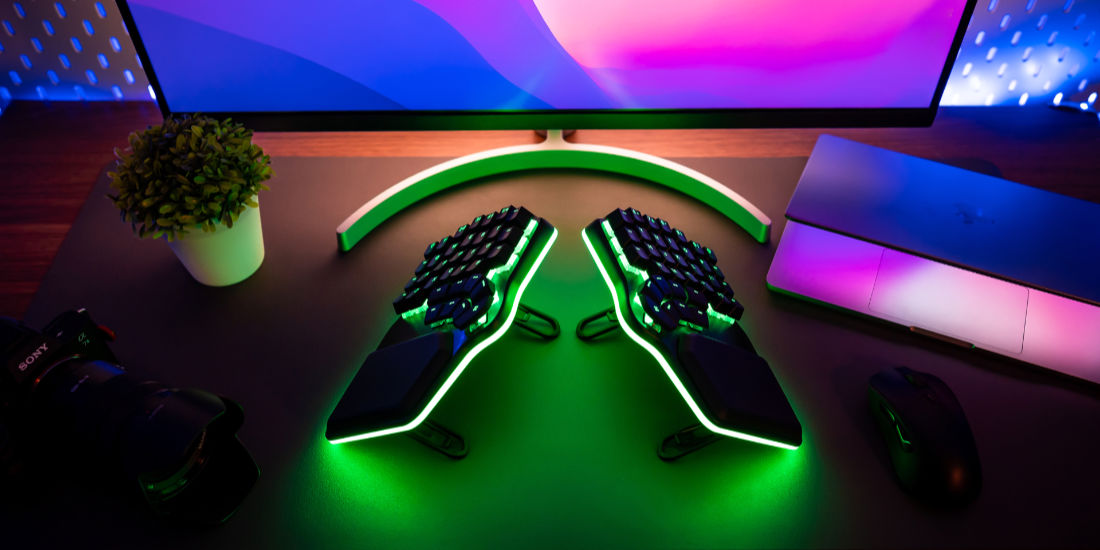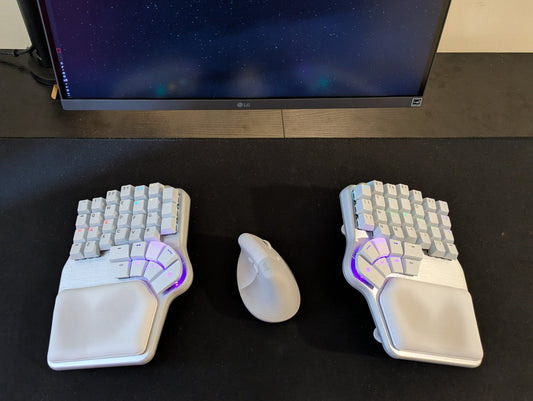With the Kickstarter of the Dygma Defy live, we wanted to properly show our new ergonomic keyboard and go over every single thing it brings to the table - hopefully, your table.
So, welcome to a tour of the Dygma Defy and its benefits and features.
Avoid ulnar deviation with its split design
First of all, let’s go over the “obvious”, at least for those of you who already have an ergonomic keyboard. The split design.
This is something mandatory if you want to call your keyboard ergonomic.

Look at how your hands are placed on a conventional keyboard. You tend to bend them outwards. That’s called ulnar deviation, which will cause pain in the ulnar nerve in the long run.
But this also affects your posture. Your elbows are drawn closer to your body, which pushes your shoulders forward and, ultimately, makes you slouch.
A split keyboard allows you to place your hands aligned with your forearms. This pushes your elbows to the side of your body, which allows you to open your chest, and straighten your shoulders and your back.

But that’s not the only benefit of having a split keyboard, especially one with fully-independent halves, like, the Dygma Defy.
For example, you can place anything you want between the halves, like your mouse, a tablet, a drawing pad, or a notepad. But also your coffee, some food, or even your pet!
And there’s more. You can get rid of the half that you don’t need and have much more space for your mouse or your drawing tablet. Even if you’re a leftie! That’s great for gaming, but also for video and photo editors, designers, and creators.
No more hand pronation with built-in tenting

As you can see, a split design is key to reducing ulnar deviation, but there’s another thing you need to avoid in order to enhance comfort: hand-pronation.
Hand-pronation is when your palms are facing down, which is something we do all the time while typing. Rotating your forearms puts strain on the joints, muscles, and tissues, which reduces blood circulation and can lead to pain and injuries.
So, how can we avoid that? That’s where tenting your keyboard comes in, as it lets your hands rest in a more natural position. Similar to when you catch a ball.
However, in a recent survey of the tenting kit for the Dygma Raise, we found that a “natural” position is different for everybody. Some might need a low angle, and others a very steep one.

That’s why we’ve designed the tenting of the Dygma Defy to be able to go from 7º to 60º, with many angles in between. Plus, it also has reverse tilting.
But what we’re most proud of is that the tenting legs can be folded into the body, so the keyboard lays completely flat without any extra height added.
Achieving this was a big engineering challenge because we also had to fit the underglow and the batteries in the body.
Make your wrists comfortable with palm rests and palm pads

Finally, wrist extension. That’s when your wrists bend upwards, something that happens a lot when typing on conventional keyboards.
The Dygma Defy has built-in palm rests and detachable palm pads, which let your wrists rest at a more neutral angle.
Say goodbye to cable with wireless connectivity
Another party piece of the Dygma Defy is its wireless connectivity, both Bluetooth and RF.
As you can see, the keyboard is lit without any cables -I mean, it’s lit anyways (pun intended).

That’s great if you want to use the keyboard with your tablet. Or just want a cable-free setup.
But we also wanted to clarify some things that you’ve asked us frequently:
- Wireless connectivity is an optional extra. But the wireless version will also work wired, even if you remove the batteries.
- We are aiming for a battery life of at least 20 hours with the lights on max brightness, and much more when dimmed.
- The batteries will be easily replaceable.
Type naturally with a columnar layout

Moving on now to one of the most requested features: the layout. Our first keyboard, the Dygma Raise, had a conventional layout -with the keys arranged in rows- and many of you kept asking us to make an ortho one.
A columnar layout helps reduce finger travel and feels more natural.
We could’ve gone ortholinear, but we believe that a columnar layout is the way to go. Our fingers are not all the same length, so why should all the columns be placed equally on the keyboard?
This way, your fingers easily rest on the home row.
Give your pinkies a rest with an 8-key thumb cluster

But of course, the star of the show is probably our thumb cluster.
With eight keys on each side, it might seem overkill, but we’ve designed it so any hand size can easily reach at least 5 or 6 keys. Plus, we really dig how you feel like you’re in command of a spacecraft with all these buttons.
This has allowed us to remove the modifier row, which required weird finger stretching in order to reach them. Now your strongest fingers are in charge, helping you improve your productivity and reduce pinky usage.
You can use the thumbkeys for space, enter, backspace, ctrl, alt, delete... and even ESC and Shift. But not only that; you can also easily access your layers with them.

And, if you’re the kind of person that can’t live without dedicated arrow keys, you can place them there too. Although we really encourage you to use layers and have them closer to your home row.
Notice how both rows have different heights, making it easier to reach the lower row or to press the top row without miss clicking the lower one.
And, finally, we’re very proud of the legends on the thumbkeys. This has allowed us to easily name the keys. They are L1 to L8 on the left side, and R1 to R8 on the right side.
Boost your productivity with a fully programmable keyboard

Of course, this layout and thumb cluster would be useless if you didn't have the ability to change your layout and create up to 10 custom layers.
We've been working a lot on improving our configurator software so it’s very easy to design your layers. With power-ups like combos, macros, dual-function keys, and superkeys.
- Combos allow you to use shortcuts with one keypress. For example, instead of having to press SHIFT+ALT+CTRL+S to “save for web” on Photoshop, you can bind that in one key.
- Macros take that idea to the next level and let you program a sequence of keypresses however you like. For example, the sequence jump + wait for 500 ms + crouch, can be in one key, which can be useful in shooter games.
- A dual-function key allows you to have two functions in one -duh!-: one when you tap and another one when you hold it. That way you can have space on tap and ctrl on hold. Or enter on tap and switch to layer on hold.
- Superkeys take that concept to the max, letting you have different functions on tap, hold, double-tap, tap and hold, and double-tap and hold.
Enjoy the show with full-on RGB

But let’s move now to the fun part: the RGB!
We’ve completely reworked the underglow of the keyboard. Now it's two times brighter. Just look at it compared to the Raise, which already has a great underglow.
But that’s not all, now more light shines through the keycaps, so the backlight feels twice as bright.
Note that this is a prototype, the end product will have per-key RGB, which means you can customize the color of each key independently.
Change your switches when you feel like it

The Dygma Defy is hot-swappable, which means you can change your switches anytime. That’s very practical if you want to try out new ones. But also, if one of them goes rogue, you can simply change it, and not buy another keyboard.
High-end aluminum body

Second, the Dygma Defy has an anodized aluminum body, which makes it sturdy, light, and, especially, very good-looking. Both black and silver are just (chef’s kiss), and with time we can make limited edition colors like with the Dygma Raise.
How much will the Dygma Defy cost
We wanted the Dygma Defy to have a similar price as the Raise -which starts at $319- but we also wanted it to have extra features, like built-in tenting, wireless connectivity, and a better underglow, among others.

However, with production costs rising and realizing that not everybody wants to pay for all those features, we found a great solution: we would offer a base Dygma Defy that you could customize with add-ons, like toppings on a pizza 🍕
So, to sum up: on Kickstarter, the base Dygma Defy will cost €279 (roughly $299), and you’ll be able to add the extras you want.
Those extras are wireless connectivity, tenting, and underglow. The per-key RGB backlight is standard, which means you can customize the color of each key independently. The good news is the extras will be heavily discounted during the campaign and will cost €50 each.
Hope that explained everything you need to know about the Dygma Defy, but feel free to write us at contact@dygma.com with any questions.
Talk soon!
— The Dygma Team









